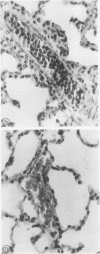Abstract
Acute leukopenia occurs in all patients during the first hour of hemodialysis with cellophanemembrane equipment. This transient cytopenia specifically involves granulocytes and monocytes, cells which share plasma membrane reactivity towards activated complement components. The present studies document that complement is activated during exposure of plasma to dialyzer cellophane, and that upon reinfusion of this plasma into the venous circulation, granulocyte and monocyte entrapment in the pulmonary vasculature is induced. During early dialysis, conversion of both C3 and factor B can be demonstrated in plasma as it leaves the dialyzer. Moreover, simple incubation of human plasma with dialyzer cellophane causes conversion of C3 and factor B, accompanied by depletion of total hemolytic complement and C3 but sparing of hemolytic C1. Reinfusion of autologous, cellophane-incubated plasma into rabbits produces selective granulocytopenia and monocytopenia identical to that seen in dialyzed patients. Lungs from such animals reveal striking pulmonary vessel engorgement with granulocytes. The activated complement component(s) responsible for leukostasis has an approximate molecular weight of 7,000-20,000 daltons. Since it is generated in C2-deficient plasma and is associated with factor B conversion, it is suggested that activation of complement by dialysis is predominantly through the altermative pathway.
Full text
PDF
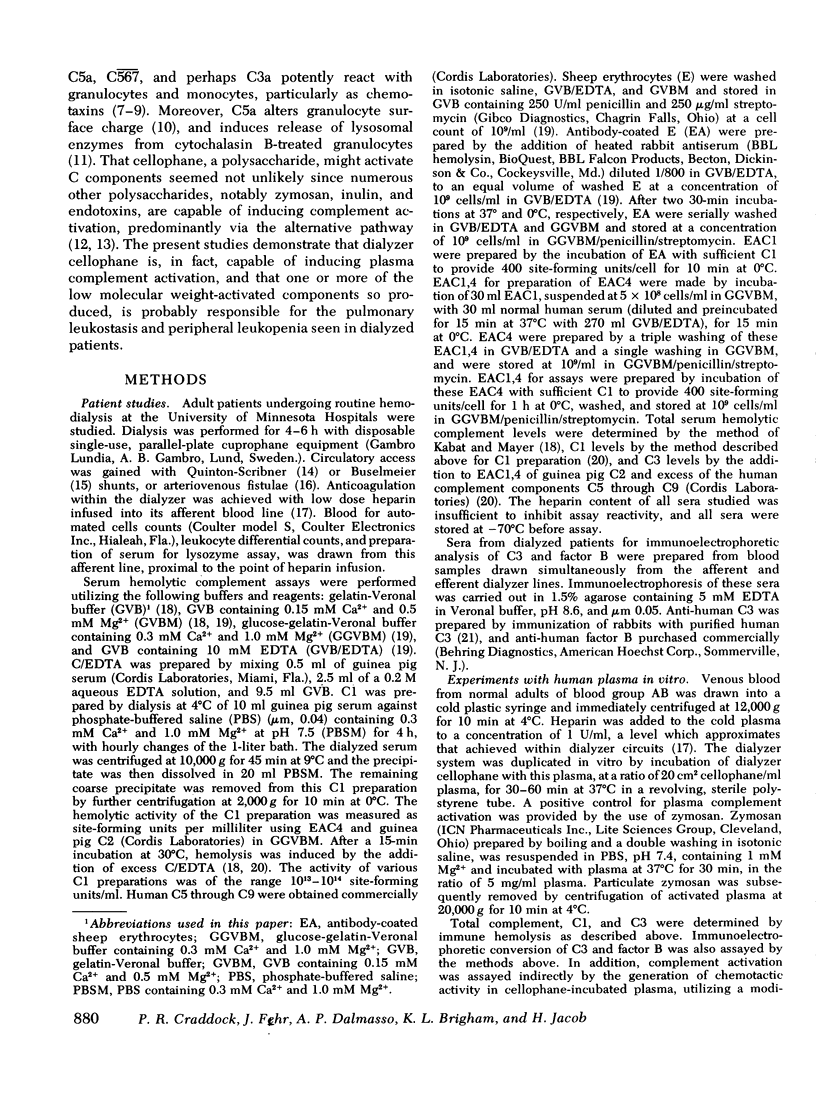
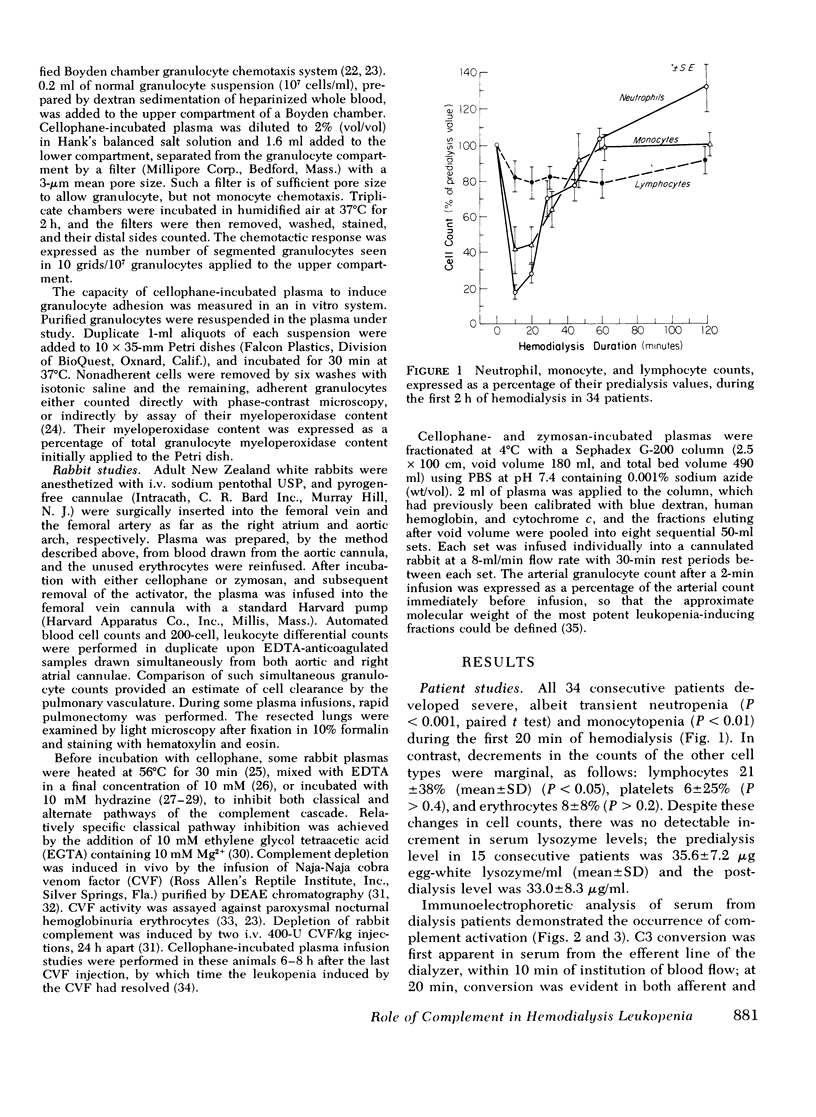
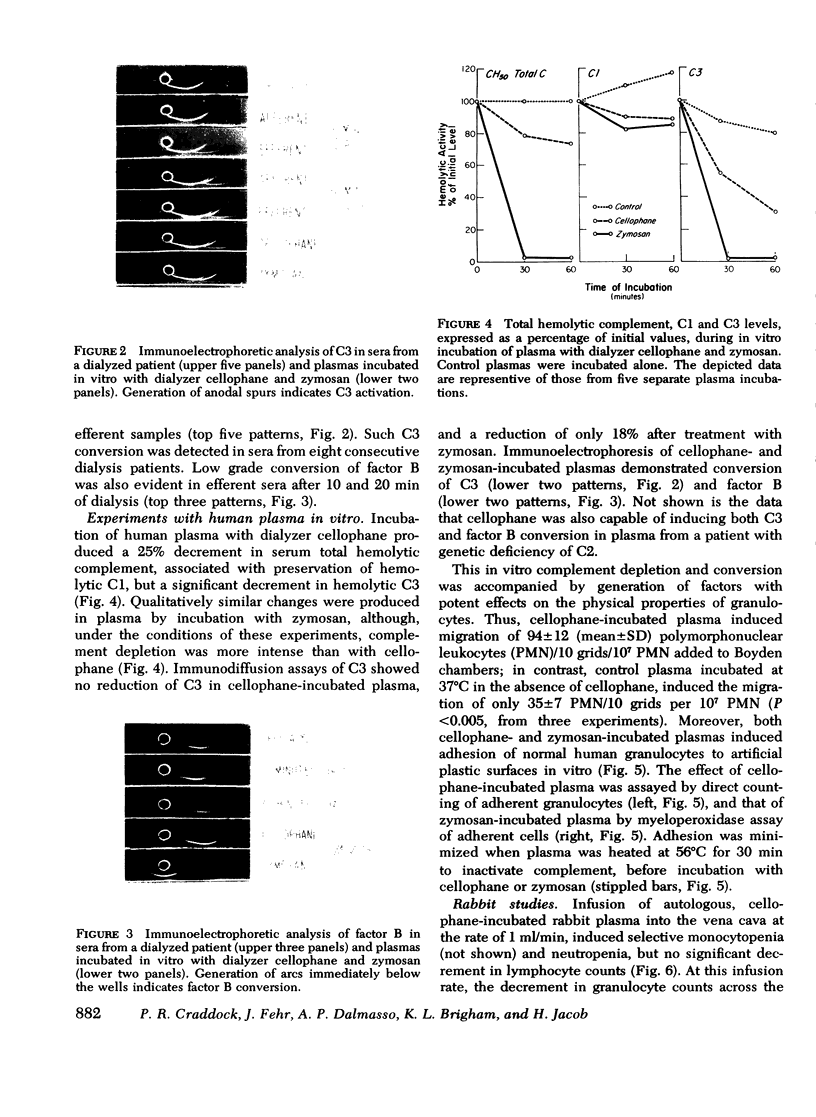

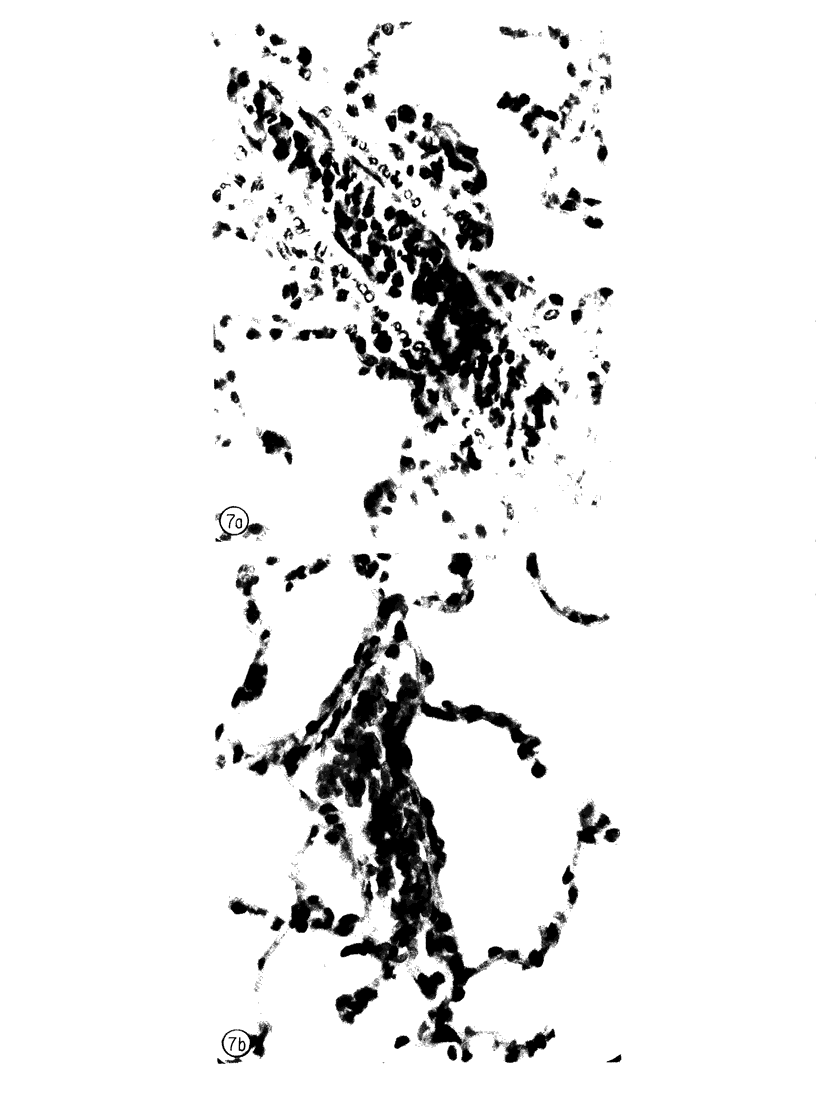
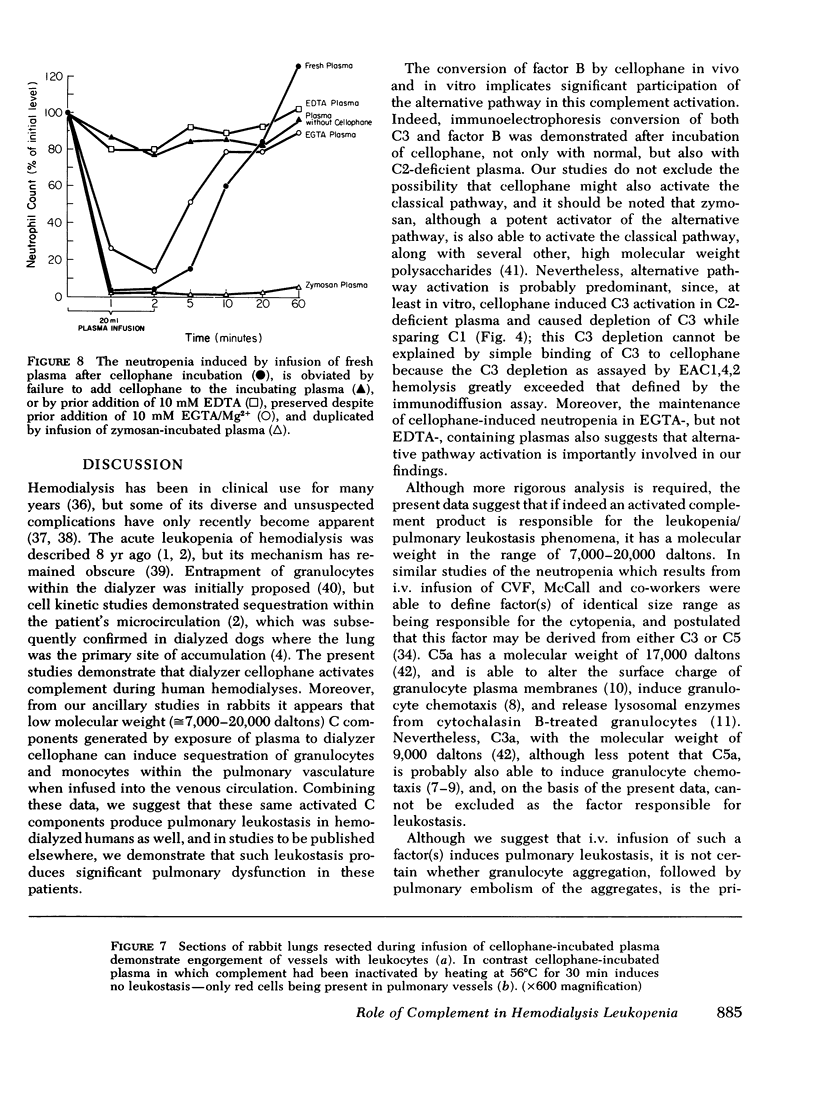
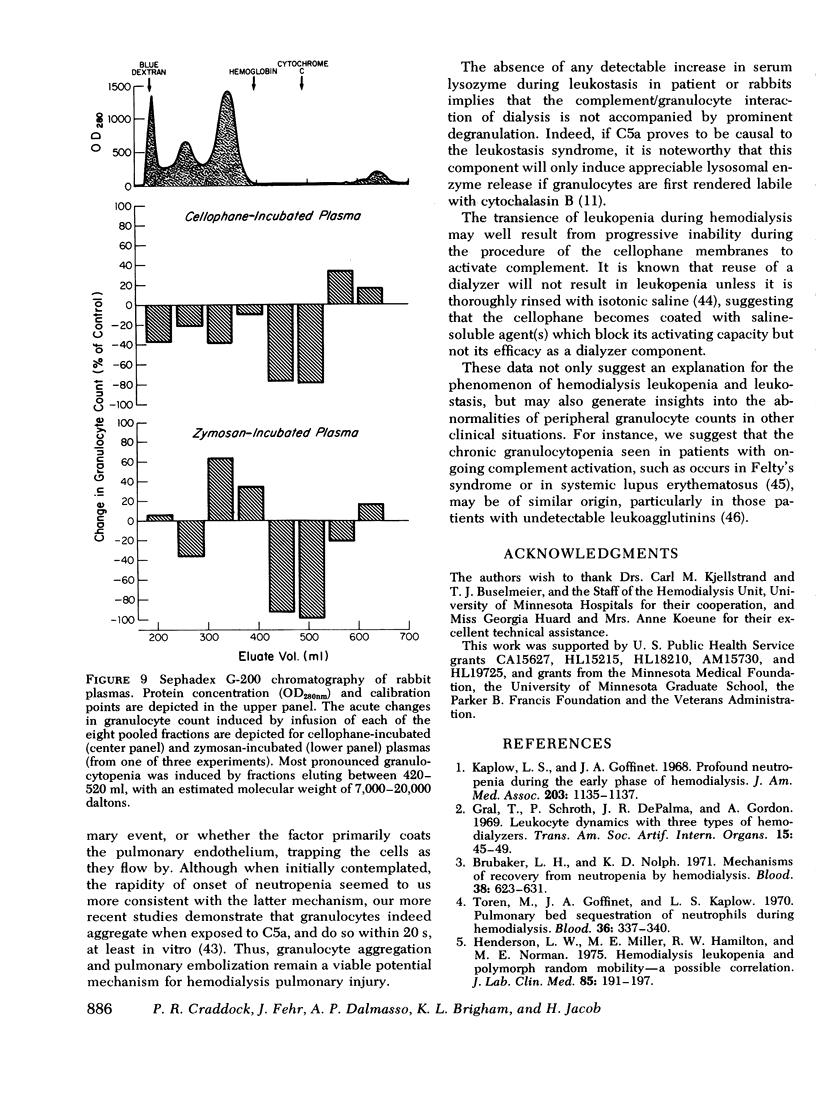
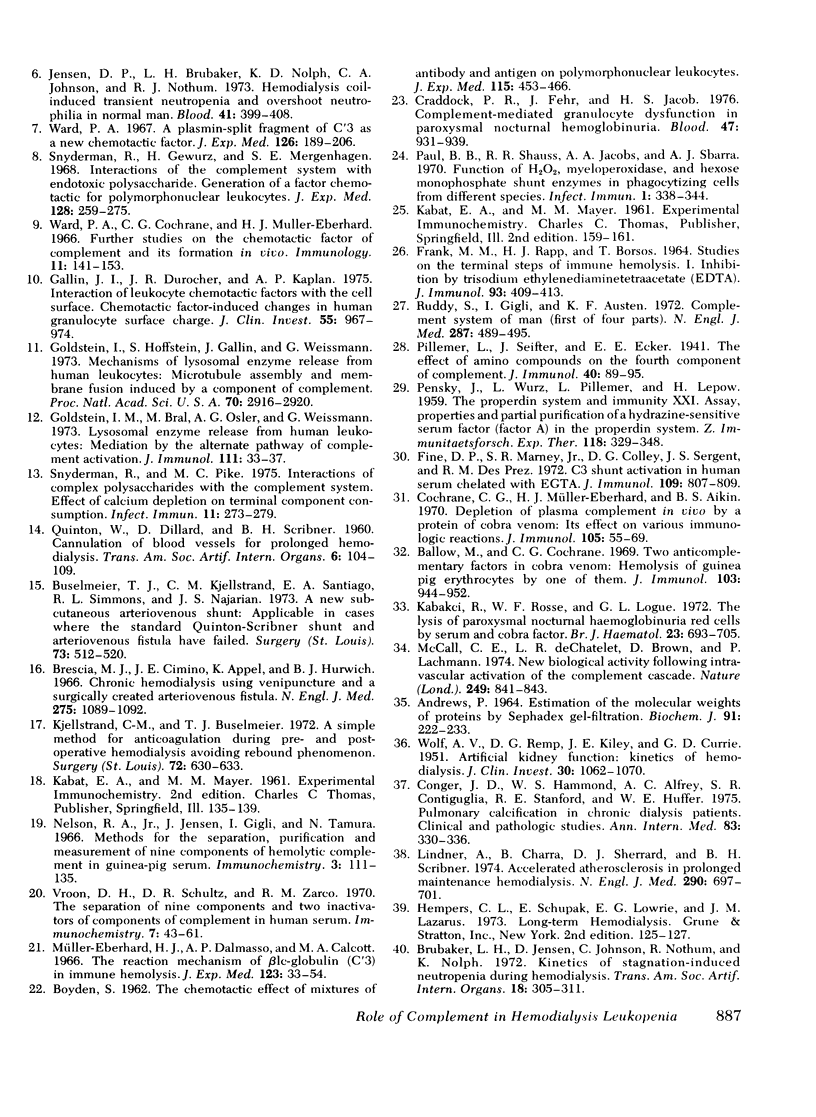
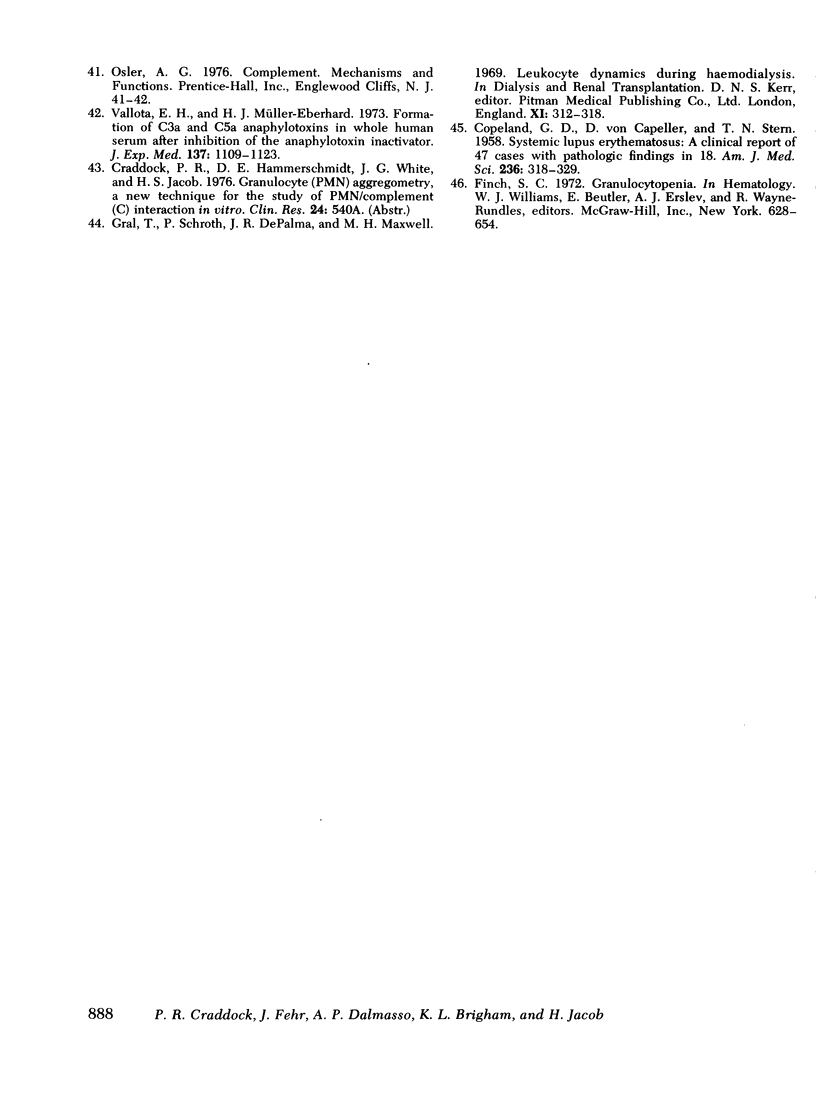
Images in this article
Selected References
These references are in PubMed. This may not be the complete list of references from this article.
- Andrews P. Estimation of the molecular weights of proteins by Sephadex gel-filtration. Biochem J. 1964 May;91(2):222–233. doi: 10.1042/bj0910222. [DOI] [PMC free article] [PubMed] [Google Scholar]
- BOYDEN S. The chemotactic effect of mixtures of antibody and antigen on polymorphonuclear leucocytes. J Exp Med. 1962 Mar 1;115:453–466. doi: 10.1084/jem.115.3.453. [DOI] [PMC free article] [PubMed] [Google Scholar]
- Ballow M., Cochrane C. G. Two anticomplementary factors in cobra venom: hemolysis of guinea pig erythrocytes by one of them. J Immunol. 1969 Nov;103(5):944–952. [PubMed] [Google Scholar]
- Brescia M. J., Cimino J. E., Appel K., Hurwich B. J. Chronic hemodialysis using venipuncture and a surgically created arteriovenous fistula. N Engl J Med. 1966 Nov 17;275(20):1089–1092. doi: 10.1056/NEJM196611172752002. [DOI] [PubMed] [Google Scholar]
- Brubaker L. H., Jensen D., Johnson C., Nothum R., Nolph K. Kinetics of stagnation-induced neutropenia during hemodialysis. Trans Am Soc Artif Intern Organs. 1972;18(0):305–311. doi: 10.1097/00002480-197201000-00077. [DOI] [PubMed] [Google Scholar]
- Brubaker L. H., Nolph K. D. Mechanisms of recovery from neutropenia induced by hemodialysis. Blood. 1971 Nov;38(5):623–631. [PubMed] [Google Scholar]
- Buselmeier T. J., Kjellstrand C. M., Santiago E. A., Simmons R. L., Najarian J. S. A new subcutaneous arteriovenous shunt: applicable in cases where the standard Quinton-Scribner shunt and arteriovenous fistula have failed. Surgery. 1973 Apr;73(4):512–520. [PubMed] [Google Scholar]
- COPELAND G. D., VON CAPELLER D., STERN T. N. Systemic lupus erythematosus: a clinical report of 47 cases with pathologic findings in 18. Am J Med Sci. 1958 Sep;236(3):318–329. [PubMed] [Google Scholar]
- Cochrane C. G., Müller-Eberhard H. J., Aikin B. S. Depletion of plasma complement in vivo by a protein of cobra venom: its effect on various immunologic reactions. J Immunol. 1970 Jul;105(1):55–69. [PubMed] [Google Scholar]
- Conger J. D., Hammond W. S., Alfrey A. C., Contiguglia S. R., Stanford R. E., Huffer W. E. Pulmonary calcification in chronic dialysis patients. Clinical and pathologic studies. Ann Intern Med. 1975 Sep;83(3):330–336. doi: 10.7326/0003-4819-83-3-330. [DOI] [PubMed] [Google Scholar]
- Craddock P. R., Fehr J., Jacob H. S. Complement-mediated granulocyte dysfunction in paroxysmal nocturnal hemoglobinuria. Blood. 1976 Jun;47(6):931–939. [PubMed] [Google Scholar]
- FRANK M. M., RAPP H. J., BORSOS T. STUDIES ON THE TERMINAL STEPS OF IMMUNE HEMOLYSIS. I. INHIBITION BY TRISODIUM ETHYLENEDIAMINETETRAACETATE (EDTA). J Immunol. 1964 Sep;93:409–413. [PubMed] [Google Scholar]
- Fine D. P., Marney S. R., Jr, Colley D. G., Sergent J. S., Des Prez R. M. C3 shunt activation in human serum chelated with EGTA. J Immunol. 1972 Oct;109(4):807–809. [PubMed] [Google Scholar]
- Gallin J. I., Durocher J. R., Kaplan A. P. Interaction of leukocyte chemotactic factors with the cell surface. I. Chemotactic factor-induced changes in human granulocyte surface charge. J Clin Invest. 1975 May;55(5):967–974. doi: 10.1172/JCI108026. [DOI] [PMC free article] [PubMed] [Google Scholar]
- Goldstein I. M., Brai M., Osler A. G., Weissmann G. Lysosomal enzyme release from human leukocytes: mediation by the alternate pathway of complement activation. J Immunol. 1973 Jul;111(1):33–37. [PubMed] [Google Scholar]
- Goldstein I., Hoffstein S., Gallin J., Weissmann G. Mechanisms of lysosomal enzyme release from human leukocytes: microtubule assembly and membrane fusion induced by a component of complement. Proc Natl Acad Sci U S A. 1973 Oct;70(10):2916–2920. doi: 10.1073/pnas.70.10.2916. [DOI] [PMC free article] [PubMed] [Google Scholar]
- Gral T., Schroth P., De Palma J. R., Gordon A. Leukocyte dynamics with three types of hemodialyzers. Trans Am Soc Artif Intern Organs. 1969;15:45–49. [PubMed] [Google Scholar]
- Henderson L. W., Miller M. E., Hamilton R. W., Norman M. E. Hemodialysis leukopenia and polymorph random mobility-a possible correlation. J Lab Clin Med. 1975 Feb;85(2):191–197. [PubMed] [Google Scholar]
- Jensen D. P., Brubaker L. H., Nolph K. D., Johnson C. A., Nothum R. J. Hemodialysis coil-induced transient neutropenia and overshoot neutrophilia in normal man. Blood. 1973 Mar;41(3):399–408. [PubMed] [Google Scholar]
- Kabakçi T., Rosse W. F., Logue G. L. The lysis of paroxysmal nocturnal haemoglobinuria red cells by serum and cobra factor. Br J Haematol. 1972 Dec;23(6):693–705. doi: 10.1111/j.1365-2141.1972.tb03484.x. [DOI] [PubMed] [Google Scholar]
- Kaplow L. S., Goffinet J. A. Profound neutropenia during the early phase of hemodialysis. JAMA. 1968 Mar 25;203(13):1135–1137. [PubMed] [Google Scholar]
- Kjellstrand C. M., Buselmeier T. J. A simple method for anticoagulation during pre- and postoperative hemodialysis, avoiding rebound phenomenon. Surgery. 1972 Oct;72(4):630–633. [PubMed] [Google Scholar]
- Lindner A., Charra B., Sherrard D. J., Scribner B. H. Accelerated atherosclerosis in prolonged maintenance hemodialysis. N Engl J Med. 1974 Mar 28;290(13):697–701. doi: 10.1056/NEJM197403282901301. [DOI] [PubMed] [Google Scholar]
- McCall C. E., De Chatelet L. R., Brown D., Lachmann P. New biological activity following intravascular activation of the complement cascade. Nature. 1974 Jun 28;249(460):841–843. doi: 10.1038/249841a0. [DOI] [PubMed] [Google Scholar]
- Müllerèberhard H. J., Dalmasso A. P., Calcott M. A. The reaction mechanism of beta-1C-globulin (C'3) in immune hemolysis. J Exp Med. 1966 Jan 1;123(1):33–54. doi: 10.1084/jem.123.1.33. [DOI] [PMC free article] [PubMed] [Google Scholar]
- Nelson R. A., Jr, Jensen J., Gigli I., Tamura N. Methods for the separation, purification and measurement of nine components of hemolytic complement in guinea-pig serum. Immunochemistry. 1966 Mar;3(2):111–135. doi: 10.1016/0019-2791(66)90292-8. [DOI] [PubMed] [Google Scholar]
- PENSKY J., WURZ L., PILLEMER L., LEPOW I. H. The properdin system and immunity. XII. Assay, properties and partial purification of a hydrazine-sensitive serum factor (factor A) in the properdin system. Z Immun exp ther. 1959 Oct-Nov;118:329–348. [PubMed] [Google Scholar]
- Paul B. B., Strauss R. R., Jacobs A. A., Sbarra A. J. Function of h(2)o(2), myeloperoxidase, and hexose monophosphate shunt enzymes in phagocytizing cells from different species. Infect Immun. 1970 Apr;1(4):338–344. doi: 10.1128/iai.1.4.338-344.1970. [DOI] [PMC free article] [PubMed] [Google Scholar]
- QUINTON W., DILLARD D., SCRIBNER B. H. Cannulation of blood vessels for prolonged hemodialysis. Trans Am Soc Artif Intern Organs. 1960 Apr 10;6:104–113. [PubMed] [Google Scholar]
- Ruddy S., Gigli I., Austen K. F. The complement system of man. I. N Engl J Med. 1972 Sep 7;287(10):489–495. doi: 10.1056/NEJM197209072871005. [DOI] [PubMed] [Google Scholar]
- Snyderman R., Gewurz H., Mergenhagen S. E. Interactions of the complement system with endotoxic lipopolysaccharide. Generation of a factor chemotactic for polymorphonuclear leukocytes. J Exp Med. 1968 Aug 1;128(2):259–275. doi: 10.1084/jem.128.2.259. [DOI] [PMC free article] [PubMed] [Google Scholar]
- Snyderman R., Pike M. C. Interaction of complex polysaccharides with the complement system: effect of calcium depletion on terminal component consumption. Infect Immun. 1975 Feb;11(2):273–279. doi: 10.1128/iai.11.2.273-279.1975. [DOI] [PMC free article] [PubMed] [Google Scholar]
- Toren M., Goffinet J. A., Kaplow L. S. Pulmonary bed sequestration of neutrophils during hemodialysis. Blood. 1970 Sep;36(3):337–340. [PubMed] [Google Scholar]
- Vallota E. H., Müller-Eberhard H. J. Formation of C3a and C5a anaphylatoxins in whole human serum after inhibition of the anaphylatoxin inactivator. J Exp Med. 1973 May 1;137(5):1109–1123. doi: 10.1084/jem.137.5.1109. [DOI] [PMC free article] [PubMed] [Google Scholar]
- Vroon D. H., Schultz D. R., Zarco R. M. The separation of nine components and two inactivators of components of complement in humansserum. Immunochemistry. 1970 Jan;7(1):43–61. doi: 10.1016/0019-2791(70)90029-7. [DOI] [PubMed] [Google Scholar]
- WOLF A. V., REMP D. G., KILEY J. E., CURRIE G. D. Artificial kidney function; kinetics of hemodialysis. J Clin Invest. 1951 Oct;30(10):1062–1070. doi: 10.1172/JCI102526. [DOI] [PMC free article] [PubMed] [Google Scholar]
- Ward P. A. A plasmin-split fragment of C'3 as a new chemotactic factor. J Exp Med. 1967 Aug 1;126(2):189–206. doi: 10.1084/jem.126.2.189. [DOI] [PMC free article] [PubMed] [Google Scholar]
- Ward P. A., Cochrane C. G., Muller-Eberhard H. J. Further studies on the chemotactic factor of complement and its formation in vivo. Immunology. 1966 Aug;11(2):141–153. [PMC free article] [PubMed] [Google Scholar]



